
|   |

|   |
The 9th International Convention of SPIC MACAY - Manjari Sinha e-mail: manjari@sinha.com Photos courtesy: Spic Macay June 19, 2024  Indrasen Reddy, Governor of Tripura and music composer Ilayaraja The 9th International Convention of SPIC MACAY (Society for Promotion of Indian Classical Music & Culture Amongst Youth) was held from May 20 to 26, 2024 at the Indian Institute of Technology Madras (IITM), Tamilnadu. It was inaugurated by Indrasen Reddy, Governor of Tripura, with music composer Ilayaraja as the guest of honour. Prof. V. Kamakoti, Director IITM, extended his full support as the gracious host to the mammoth event. He expressed his happiness over the fact that the IITM has been a part of the cultural revolution spearheaded by Dr. Kiran Seth for 46 years. It was the third time that the IITM was hosting this annual convention. 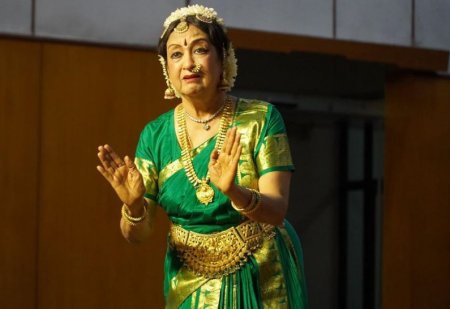 Dr. Padma Subrahmanyam The inaugural concert by Dr. Padma Subrahmanyam gave this year's Intercon a flying start. Her regal stage presence and the alchemy of her inner fire of devotion transcend formal prescriptions that make all the difference. Opening with "Siddhi Vinayakam seveham" in Mohan Kalyani, she presented the story of little Vinayaka swallowing the Vishnu Chakra. All the pleadings of Vishnu to get it back failed until he performed 'Thopukaranam', catching both his ears with crossed hands while sitting and getting up many times. Naughty Vinayaka laughs at his plight and ultimately gives back his Chakra. The second piece was on Navavidha Bhakti, the nine kinds of devotion elaborated through Rama Katha, the story of Rama. Kirtanam through the example of Valmiki who wrote the epic Ramayana for the glory of Rama, Smaranam through Seetha, who always remembered Rama keeping him in her heart and soul, Sevanam was depicted through the 'Seva-Bhava' of Bharata who kept Rama's Charana Paduka as a token of service to his kingdom in place of Raja Rama. Likewise, Archanam by Shabari, Vandanam by Vibhishana, Dasyam by Lakshmana, Sakhyam by the enactment of Sugreeva, and Atma Nivedanam through the example of Jatayu. "Baro Krishnaiyya" (Come to my home, O Krishna), the Kanaka Dasa pada was danced with intense devotion, before Padma concluded her recital with the lively folk dance 'Karagam'. This depicted the priest playing the drum and the devotees of Goddess Mariyamman dancing with the neem leaves while balancing a pot on their heads. They get into a trance with increasing rhythm as the performance reaches its crescendo. It was amazing to see the dancer's stamina at eighty, maintaining her impeccable poise and delicate grace. The live orchestra with Guru Bharadwaj on mridangam, Kannan Balakrishnan on veena, Gayatri and Radhika providing the vocal support, enhanced the exquisite Bharata Nrityam. 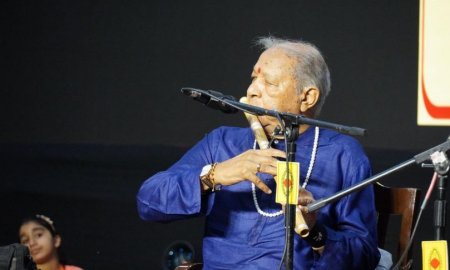 Pt. Hariprasad Chaurasia Pt. Hariprasad Chaurasia was the other luminary of the inaugural evening. His melodious Yaman, despite his trembling fingers, transported the listeners to a divine, spiritual realm, where the joy of artful music could be experienced equally by both connoisseurs and the lay listeners like most of the young students that comprised the large audience. The concluding folk tune had the devotional fervor of the Bangala Kirtan. Assisted on flute by his disciple Vaishnavi Prasad, Chaurasia was accompanied on tabla by Ashish Lalwani. 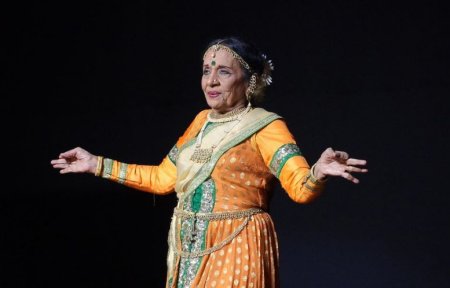 Sunayana Hazarilal The veteran Kathak exponent from the Janaki Prasad tradition of Benaras Gharana, Sunayana Hazarilal opened her recital with Krishna Vandana "Bhaje Brijesh Nandanam... Namaami Krishna Nayakam" where kavitta added an authentic flavor of her Benaras Gharana. The uthaan next was interspersed with the impromptu 'Farshabandi'. Sunayana presented rare compositions of her Guru and husband Pt. Hazarilal. The Tode-Tukde Paran et al depicted the tete-a-tete between a husband and wife, in a dramatic combination of tandav and lasya ang. She also presented her senior disciple Aruna Bharati Swamy performing the Tipalli Paran and Chakkardar Tihais. Sunayana then presented Taar Parans with different story lines. 'Taar Paran is a Toda with meaning,' she explained and presented quite a few Taar-Parans with a variety of stories. The one with 'Karke Kangan' was about the viraha of Gopis when Krishna left for Mathura. Another Taar-Paran was about 'Ashta-Nayika' focusing on abhisarika. Her abhinaya piece was based on the depiction of 'Vasakasajja' on the Benarasi Dadra "Baanke more Saiyaan" in raga Bhinna Shadja, set to Addha Theka of Teentala. Depicting her beloved as an expert horse rider or an efficient warrior, she performed sparkling foot work, but was disappointed with the 'non-cooperation' of the sound system. Sunayana concluded her Kathak recital with her disciple Bharati, presenting a Sawal-Jawab sequence with the tabla. The live orchestra had Somnath on vocals, Kalinath Mishra on tabla, and a lady sitarist. The evening had opened with a Carnatic violin recital by A. Kanyakumari from the Vijayanagaram tradition of Dwaram Venkataswamy Naidu. 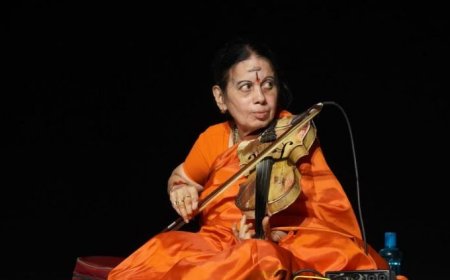 A. Kanyakumari 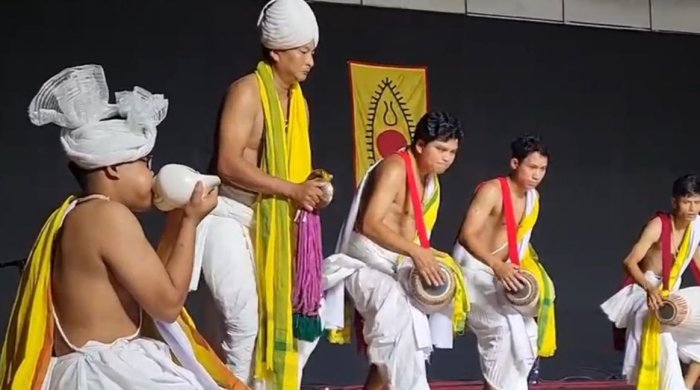 Khumuko Romendro Singh & troupe Pung Cholam by Khumuko Romendro Singh and troupe attracted the young audiences with not just their percussion instrument but with their white attire and white Pagri (the headgear) as well. It was intriguing to see them holding the pung hung on their shoulders while they played it and danced too all at once, the chanting of Shri Radhe-Govindo, while one of them played conch shell and some of them played Kartal, doing the Kartal Cholam. Opening with an invocation to Gaurang Mahaprabhu and Guru Vandana, this dance had a sense of piety. So were the Gurubani by Alankar Singh and Baul Gaan by Parwati Baul. 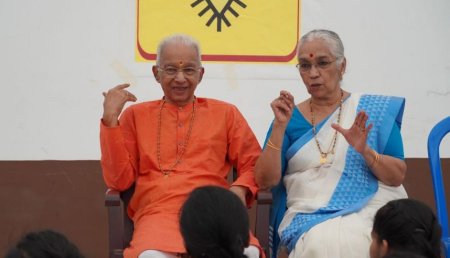 The Dhananjayans The morning intensive workshops had Gurus V.P. Dhananjayan and Shanta Dhananjayan taking Bharatanatyam, N. Shailaja taking Kuchipudi, Guru Margi Madhu taking Koodiyattam, Kalamandalam Sugandhi taking Mohiniyattam, Kathakali by Kalamandalam M.P.S. Namboodiri, Purulia Chhau by Tarapad Rajak and Guru Madhavi Mudgal took Odissi. If Shailaja made the students recite the shlokas along with learning samyukta and asamyukta hastas, Madhavi Mudgal made the students sing the Saraswati Vandana in Bhimpalasi, learning the meaning of the Sanskrit shloka while teaching the dance postures and body movements. 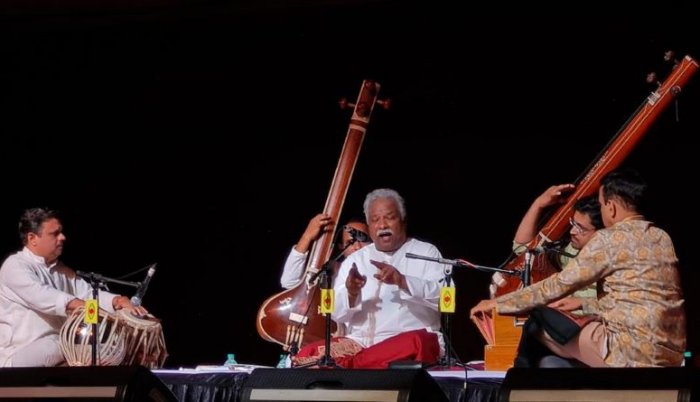 Pt Venkatesh Kumar The evening performances also had Hindustani classical by Pt. Ulhas Kashalkar, Pt. Venkatesh Kumar, sitar recital by Ud. Shahid Parvez and Carnatic vocal by Neyveli Santhanagopalan, Saraswathi veena recital by Jayanthi Kumaresh, violin recital by GJR Krishnan et al. The 9th International Convention came to a close with the overnight festival with the sonorous sarod recital by Ud. Amjad Ali Khan, Carnatic vocal by Sudha Raghunathan, Hindustani vocal by Ashwini Bhide Deshpande, Koodiyattam based on Kalyana Saugandhikam by Margi Madhu and his Nepathya repertory. The overnight concert reached its serene climax with the Dhrupad recital by Ud. Wasifuddin Dagar at the Brahma Muhurta. The participants of this weeklong convention were privileged to stay in close proximity of our intangible cultural heritage and ethics as they interacted with the greatest of Gurus and artistes at close quarters. Activities ranged from classical music and dance concerts to folk music, dance, puppetry, and theatre performances. There were also crafts workshops, classic film screenings followed by discussions and heritage walks. The Ashram-like routine started at morning 4am with Hatha Yoga and Naad Yoga Sadhana under proper guidance. The intensive workshops during the first half of the day, followed by lunch had afternoon sessions with a variety of performances, film screenings, and talks by stalwarts from various disciplines. 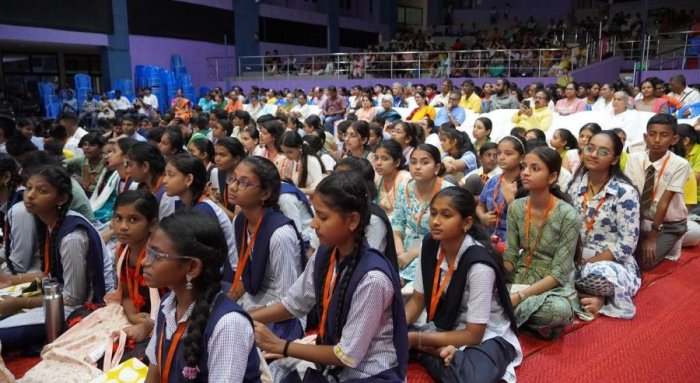 The core purpose of these annual conventions is to have every child experience the ethos of our cultural heritage and get inspiration to mould their lives accordingly. The vision of Dr Kiran Seth is to reach every child by 2030. 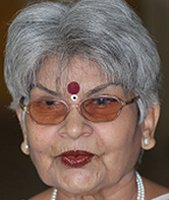 Manjari Sinha has an M.A. in Sanskrit and Music, and Sangeet Prabhakar in vocal, tabla, sitar and Kathak dance. She has regular columns in national dailies as a music and dance critic. |